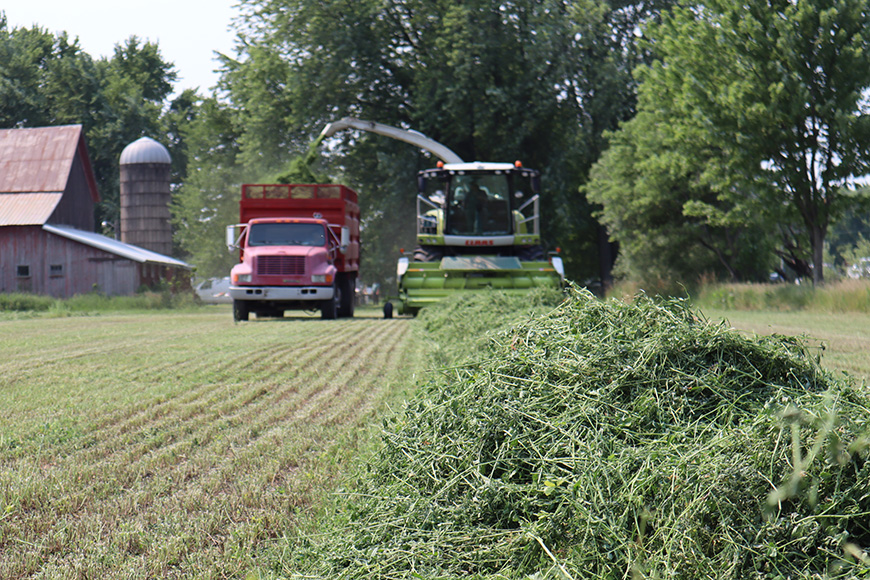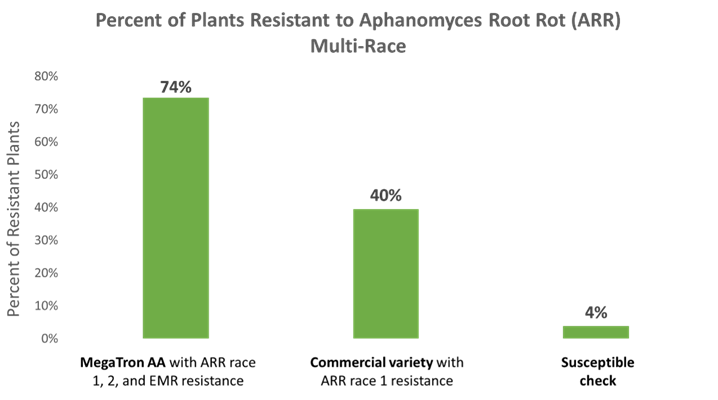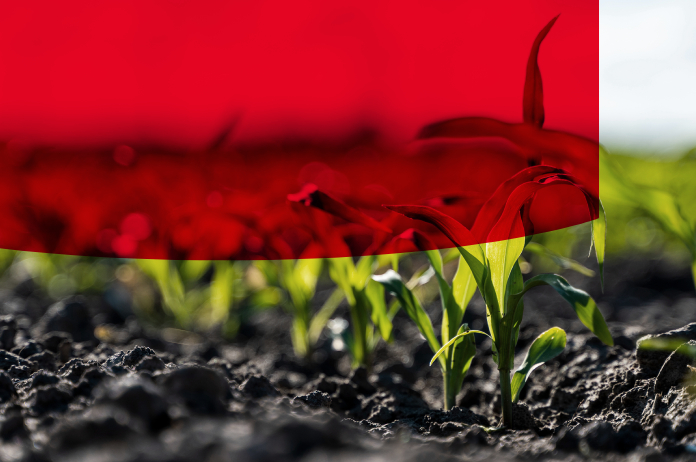Feb 28, 2022
Manage Alfalfa Diseases With Advanced Genetics
Randy Welch
National Alfalfa Agronomist

Healthy roots, stems and leaves lead to higher alfalfa yield potential. Above ground, stems and leaves produce and transport plant energy to make valuable forage. Below ground, alfalfa roots gather water and nutrients. While the soil holds many components alfalfa plants need to thrive, it can also contain destructive soilborne diseases like Aphanomyces root rot and Anthracnose.
Diseases can limit key plant processes, negatively impacting forage yield and quality potential. Understanding these costly threats and prioritizing improved disease resistance packages can help you establish stronger stands, healthier plants and higher yield potential.
Aphanomyces can be found in most soils that are saturated and poorly drained, especially during stand establishment. Oftentimes, soil compaction and limited water dispersal will aggravate the disease symptoms. Herbicide carryover from many commonly used herbicides from prior crops can complicate this disease diagnosis. Multiple races have been identified in the Midwest, East and areas of the Pacific Northwest, including race 1, race 2 and more recently enhanced multi-race, which was previously known as race 2/3.
There are multiple races of anthracnose. Race 1, race 2 and recently race 5 have been identified to cause economic damage to alfalfa. Race 5 is a very destructive race that often shows up earlier than previous races and during the first season of growth. Race 5 Anthracnose is most aggressive during warm, moist, and higher rainfall periods during mid-summer and fall. Anthracnose spores readily spread from stem to stem and plant to plant through wind, rain and harvesting equipment.
Enhanced multi-pathogen disease resistance is built into the newly launched alfalfa varieties from CROPLAN. New varieties with enhanced disease resistance are designated with “AA” in the variety name. The AA varieties provide growers higher yield and forage quality potential from increased plant health.
Plus, we are the first and only company to receive patent approval covering alfalfa varieties with resistance to anthracnose race 5 in alfalfa. This patented technology is now available in CROPLAN AA varieties. So far, race 5 has been found in the Midwest and Northeast.

Data obtained from experiments by USDA-ARS-Plant Science Research Unit and WinField United. Funded in part by a grant from NAFA US Alfalfa Farmer Research Initiative.
For additional protection during seedling establishment, CROPLAN varieties include a seed treatment package, which contains GroZone® plus Advanced Coating Zn 34% along with Stamina® fungicide seed treatment and Ascend® plant growth regulator.
CROPLAN AA alfalfa varieties offer a new way for growers to enhance their preventive disease management and realize greater yield, quality and return on investment potential. Talk to your local WinField® United retailer to learn more about these varieties and how they could benefit your alfalfa acres.
1Undersander, 2018.
All photos are either the property of WinField United or used with permission.
© 2022 WinField United. Important: Before use always read and follow label instructions. Crop performance is dependent on several factors many of which are beyond the control of WinField United, including without limitation, soil type, pest pressures, agronomic practices and weather conditions. Growers are encouraged to consider data from multiple locations, over multiple years and to be mindful of how such agronomic conditions could impact results. CROPLAN and WinField are trademarks of WinField United. All other trademarks are the property of their respective owners.
Diseases can limit key plant processes, negatively impacting forage yield and quality potential. Understanding these costly threats and prioritizing improved disease resistance packages can help you establish stronger stands, healthier plants and higher yield potential.
Aphanomyces root rot
Strong, healthy roots allow the alfalfa plants to gather more soil nutrients and water to support a high-producing plant while fixing more nitrogen in the soil from healthy nodulation. In seedlings, the Aphanomyces disease causes root pruning and poor root development that often appears above ground as a stunted, yellow plant. In established alfalfa stands, Aphanomyces can continue to infect roots, stunting plant growth and producing lower yields.Aphanomyces can be found in most soils that are saturated and poorly drained, especially during stand establishment. Oftentimes, soil compaction and limited water dispersal will aggravate the disease symptoms. Herbicide carryover from many commonly used herbicides from prior crops can complicate this disease diagnosis. Multiple races have been identified in the Midwest, East and areas of the Pacific Northwest, including race 1, race 2 and more recently enhanced multi-race, which was previously known as race 2/3.
Anthracnose
Anthracnose is a severe stem and crown fungal disease that causes defoliation and stem death. It appears as oval to diamond-shaped lesions on the stem. These lesions are deep and destructive, and disrupt nutrient and water movement in the plant. Infected stems often appear wilted and display the “shepherd’s hook” once the disease has killed the stem. Anthracnose infection can cause significant yield losses of up to 25% or more.1 Crowns from infected plants decline in productivity. Once infected, crown death is likely from this pathogen.There are multiple races of anthracnose. Race 1, race 2 and recently race 5 have been identified to cause economic damage to alfalfa. Race 5 is a very destructive race that often shows up earlier than previous races and during the first season of growth. Race 5 Anthracnose is most aggressive during warm, moist, and higher rainfall periods during mid-summer and fall. Anthracnose spores readily spread from stem to stem and plant to plant through wind, rain and harvesting equipment.
Advanced disease resistance packages
Protect the roots and stems of your alfalfa with improved plant genetics. Both Aphanomyces root rot and Anthracnose can be important threats to protect your crop against. CROPLAN® seed offers disease resistance to multiple races of both Aphanomyces root rot and Anthracnose for protection both above and below ground.Enhanced multi-pathogen disease resistance is built into the newly launched alfalfa varieties from CROPLAN. New varieties with enhanced disease resistance are designated with “AA” in the variety name. The AA varieties provide growers higher yield and forage quality potential from increased plant health.
Plus, we are the first and only company to receive patent approval covering alfalfa varieties with resistance to anthracnose race 5 in alfalfa. This patented technology is now available in CROPLAN AA varieties. So far, race 5 has been found in the Midwest and Northeast.

Data obtained from experiments by USDA-ARS-Plant Science Research Unit and WinField United. Funded in part by a grant from NAFA US Alfalfa Farmer Research Initiative.
More ways to support your alfalfa crop
In addition to the disease resistance package, CROPLAN AA varieties can also include Roundup Ready® technology or HarvXtra® with Roundup Ready technology. HarvXtra alfalfa is the first genetically engineered alfalfa trait developed to maximize forage quality by reducing the amount of lignin in the plant compared to conventional alfalfa at the same stage of maturity. This means you can have a larger cutting window for greater harvest flexibility, which is especially useful in cases of inclement weather or equipment breakdowns.For additional protection during seedling establishment, CROPLAN varieties include a seed treatment package, which contains GroZone® plus Advanced Coating Zn 34% along with Stamina® fungicide seed treatment and Ascend® plant growth regulator.
CROPLAN AA alfalfa varieties offer a new way for growers to enhance their preventive disease management and realize greater yield, quality and return on investment potential. Talk to your local WinField® United retailer to learn more about these varieties and how they could benefit your alfalfa acres.
1Undersander, 2018.
All photos are either the property of WinField United or used with permission.
© 2022 WinField United. Important: Before use always read and follow label instructions. Crop performance is dependent on several factors many of which are beyond the control of WinField United, including without limitation, soil type, pest pressures, agronomic practices and weather conditions. Growers are encouraged to consider data from multiple locations, over multiple years and to be mindful of how such agronomic conditions could impact results. CROPLAN and WinField are trademarks of WinField United. All other trademarks are the property of their respective owners.
IF YOU LOVE OUR INSIGHT, YOU’LL LOVE OUR ROI POTENTIAL
Every successful harvest starts with a seed. It just can't end there. Choose which high-performing seed products you’ll start with this season.



